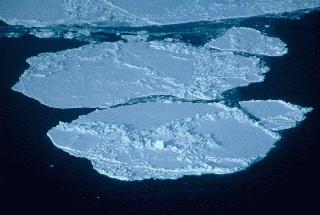Click on image for full size
Image courtesy of Mila Zinkova, Creative Commons Attribution ShareAlike license
Greenland’s Ice Is Melting Faster
Greenland, the enormous island – the world’s largest- that sits between the Arctic and Atlantic Oceans, is almost entirely covered with ice. But as our planet warms, Greenland’s ice melts. New research has found that the rate of ice melt is speeding up.
The amount of ice that melted during the summer of 2007 was the largest that scientists have seen since they first began making measurements of the ice in 1979. The rate of ice melt in the western part of Greenland has sped up by about 30% since 1979.
Konrad Steffen and his research team at the University of Colorado have a number of ways to keep an eye on Greenland’s ice sheet. From far above, satellites equipped with microwave sensors collect data that allow the team to chart where the ice is melting and how fast the ice is moving towards the ocean. On the ice, monitoring stations collect data about the ice sheet every hour. And flying over the top of the ice in a helicopter the researchers collect images with sophisticated cameras and a rotating laser to map the size and shape of tunnels called moulins.
Better understanding moulins, vertical tunnels through the ice that drain melt water down below the ice sheet, may be key to understanding the rate at which Greenland’s ice is shrinking. The melt water draining to the bottom of the ice causes the ice to slip more quickly towards the ocean - a bit like slipping on a banana peel. Outlet glaciers, the routes that ice takes towards the sea, are moving more quickly now than they were in the past. "We know the number of moulins is increasing," said Steffen. "The bigger question is how much water is reaching the bed of the ice sheet, and how quickly it gets there."
The Arctic is warming faster than other regions. For example, while Earth’s average temperature has increased by 1 degree Fahrenheit over the past century, air temperatures in Greenland have increased by about 7 degrees Fahrenheit since 1991. Because there is more warming in the Arctic, the impacts are more obvious. Greenland’s fast moving and melting ice is one of many major changes in the Arctic. There is less sea ice in the Arctic Ocean and the amount at the end of the summer of 2007 was especially small. Permafrost in Arctic tundra has been thawing too. And warming is causing Arctic ecosystems to change.
When Greenland’s ice melts, the water is added to the ocean, causing sea level to rise. Sea level also rises when icebergs calve off a glacier into the ocean. If all the ice that is on Greenland were to melt or calve into the ocean, global sea level would rise 7.2 meters (21 feet.) Currently, melting Greenland ice increases global sea level by about half a millimeter each year. If the ice melts faster, then sea level will rise faster. The more we understand about how Greenland’s ice is changing, the more we will understand about how sea level changes. So scientists continue to watch the world’s largest island and its icy cap.















